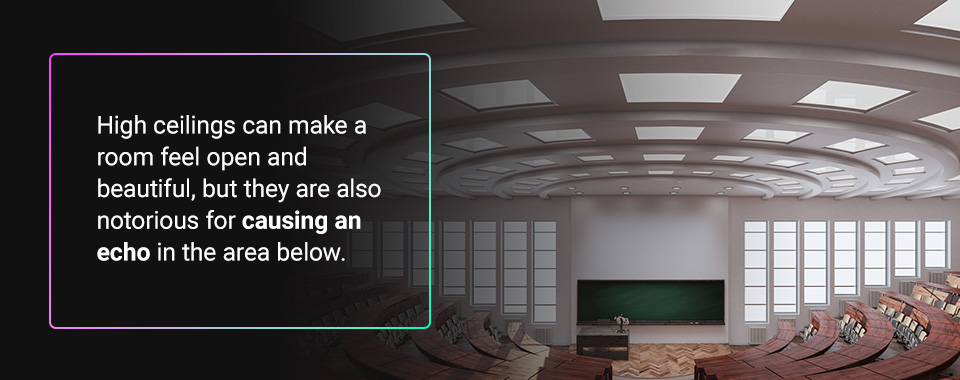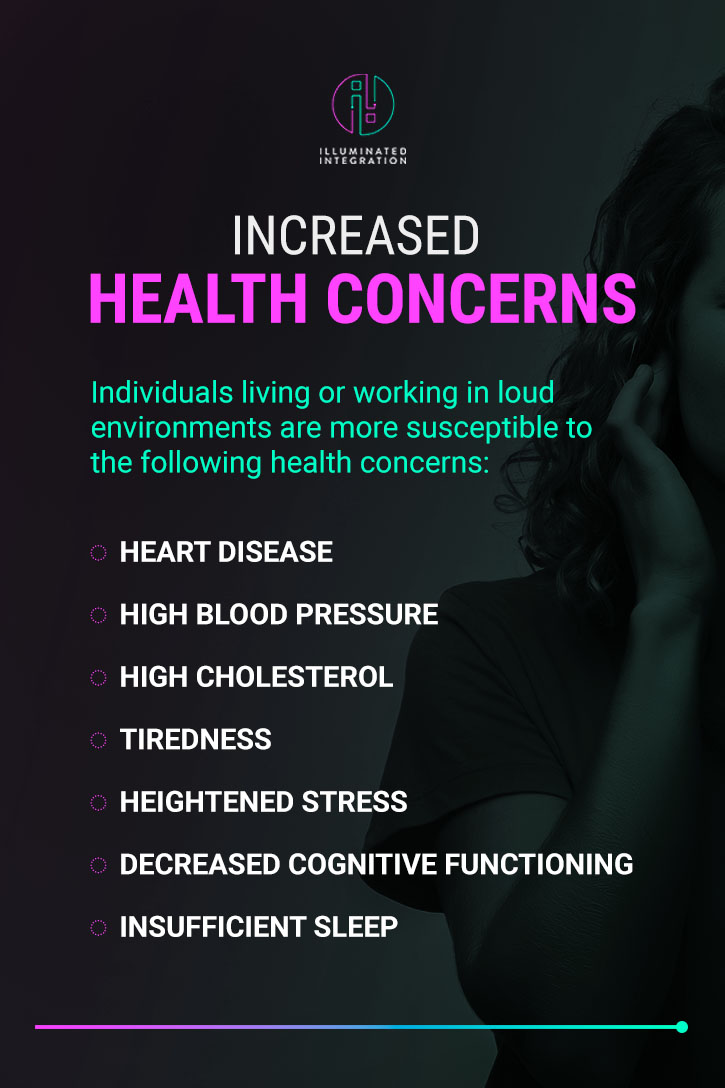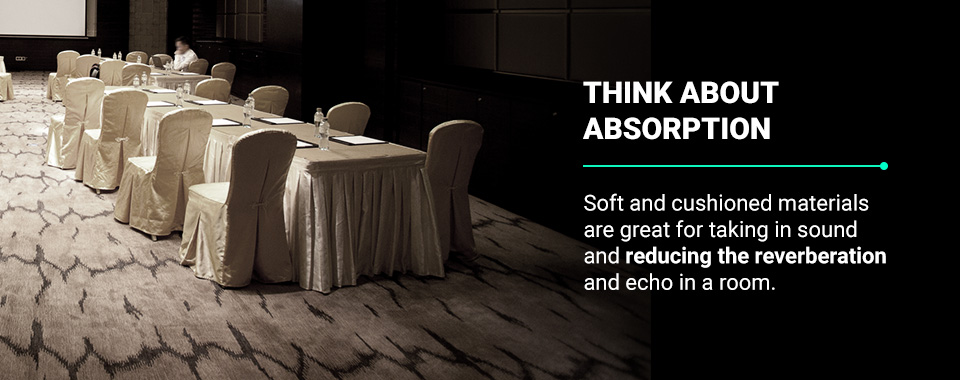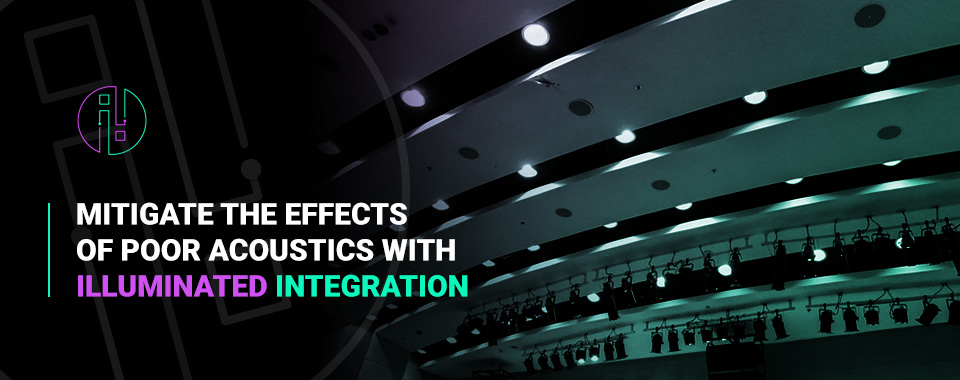

Acoustics refers to the way sound waves interact with the space around them. When this interaction results in an unpleasant auditory experience like echoing or reverberation, this means the area likely has bad acoustics.
It can be hard to focus and communicate effectively when you spend time in areas with these noise challenges. Luckily, there are ways to manage sites with excess noise and the problems associated with them.
Before you can address sound waves and acoustic issues, you need to understand how they impact the people who experience them and their effects on an environment.
Poor acoustics mean that sound waves are interacting with the space around them in a way that produces poor noise quality. When you hear echoing or reverberation, these are key indicators of bad acoustics.
If you’ve ever experienced speakers that sound great in one room but sound worse when set up in another, this is likely due to the acoustic properties of each space. The sound waves from the speaker had different elements to interact with, so they offer a different sound experience.
A space can experience problems with echo and reverberation because of one or more of the following.
Hard surfaces are one of the most common sources of echo. When a sound wave makes contact with a rigid material, it reflects back into the room and makes it challenging to hear properly. It may feel like the bouncing soundwaves are competing for your ear’s attention, making it difficult to listen or concentrate.
Hard surfaces that may be contributing to your space’s poor sound payoff include the following:
Sound waves can bounce around freely if a space has too many hard surfaces and not enough soft, absorbent materials. The more sounds reflect off surfaces in one area, the more unpleasant it is to listen.
High ceilings can make a room feel open and beautiful, but they are also notorious for causing an echo in the area below. If you’ve ever clapped in space with a high ceiling, you may have noticed the sound reverberating above your head for a period that is longer than the clap itself.
Since the ceiling is far away from most noise sources in a room or theater, it takes longer for sound waves to travel the distance and reflect back into the area below. This causes echo and can negatively impact a space’s acoustics.

If you’ve ever been to a loud restaurant and found it difficult to hear what a person directly beside you was saying, then you understand the stress that multiple noise sources have on your hearing. When you factor in poor acoustics, the problem amplifies.
A space’s acoustics may fall flat if it deals with a lot of extraneous noise from sources such as these:
Some of these sounds may occur within your space, but others will be from outside activity. Depending on the noise sources, you may need to incorporate masking and absorption when addressing the sound problems.
When a room does not have any materials that diffuse or absorb sound, you can experience some serious acoustical issues. Soft materials cut back on sound reflection and reduce echo.
Empty spaces typically have poor acoustics because the soundwaves can openly bounce back and forth without coming into contact with materials that slow them down.
The following materials can help with poor acoustics:
Beyond being an annoyance, poor acoustics can have many negative implications for the people who live and work around them.
When a space doesn’t accommodate sound well, it can be frustrating and impact your mood. If you cannot listen properly, you may miss an important message or misinterpret it. This can create a sense of stress and lead to miscommunications.
Excessive sound can make it impossible to concentrate and get work done well. Too much noise can interfere with your cognitive processing and make you feel overwhelmed, and long periods of exposure to chaotic sounds can lead to serious concerns with your mental and physical well-being. And the list doesn’t stop there.
The following are additional ways poor acoustics can affect people and their everyday activities.
If you’ve ever had to study for a test in a chaotic room, you understand how challenging it can be to focus when there is a lot of extraneous noise and activity going on around you. It can feel impossible to zone in on the material and block out voices and other sounds. Poor acoustics are very distracting and can interfere with a person’s ability to work effectively.
For employees functioning in an environment with a lot of noise, performing at their best can be difficult. Working in spaces with poor sound quality can stifle creativity and problem-solving, making it hard to find the most effective solutions and follow them through.
Poor acoustics in communication create barriers between the individuals who are talking to each other. People rely on good sound quality to exchange ideas effectively and comprehend the topics of conversation.
When there is a lot of noise and an echo is present, you can easily miss critical details or inflection from another speaker and misinterpret their point of view.
Consider being in a classroom where the ability to hear is essential for learning new information. Or, think about visiting a theater, where your experience depends on your capacity to hear what is happening. A room with proper acoustics can help voices sound clearer, making it easier to collaborate and pay attention.
People who spend a lot of time in areas with poor acoustics and loud noises can suffer physically and mentally.
Individuals living or working in loud environments are more susceptible to the following health concerns:
In some cases, people who have spent extended periods of time in loud, echoey environments can suffer from a disorder called hyperacusis, where the individual’s hearing becomes ultrasensitive. People with this condition have difficulty tolerating sounds such as the following:
While most people tune out these sounds, people with hyperacusis can experience pain when they hear these mild noises, making it hard to enjoy or even endure day-to-day living.
Bad acoustics interfere with privacy in two major ways. First, when space is too loud, people are unable to share confidential information without speaking loudly, defeating the purpose of confidentiality. Second, when a space carries sound, no one can share private insights without others hearing what is said. This is problematic in environments like offices and classrooms where people need to share personal information with each other.
Imagine the entire class listening in on a private conversation regarding your grades between you and your teacher. Or consider if your boss needed to talk to you about a mistake you made on your latest assignment. You probably don’t want the whole office hearing your feedback. Poor acoustics can take away privacy and present a real issue.
Safety concerns are among the most important aspects of poor acoustics. People must be able to hear in case of an emergency. When sound waves bounce off different surfaces and create echoes, it can be challenging to hear someone share pertinent warnings or instructions. If something were to happen, a noisy environment could quickly turn chaotic. If people cannot hear properly, this poses a risk to the safety of anyone involved.
Good acoustics are part of creating a pleasant experience in any environment. There are practical solutions to address problems with sound if your space is lacking in this area. Acoustic design and implementation professionals can help you identify your acoustical challenges and find the necessary elements to improve the sound quality.
The following are ways to fix poor acoustics to create a more enjoyable space.
Before you start adding elements into your space to mitigate sound issues, you should locate the problem first. By identifying where echo or reverberation is coming from, you can choose the right pieces to diffuse or absorb the sound.
An acoustic consultant can help you find the source of your auditory disturbances and suggest technology systems to correct any issues.
Perhaps your space has a lot of hard surfaces and needs sound-absorbing elements to lessen echo. Or, maybe your space has a high ceiling that could use foam panels to reduce reverberation. A professional can help you locate the problem and find the right solutions.
A lot goes into a room’s acoustics, including the following characteristics of the space:
A space’s organization and setup impact how sound waves travel throughout and interact with the area. If you are experiencing poor acoustics, you may want to rethink your positioning. Some minor redecorating can go a long way!
Perhaps you have a speaker directed at a glass window, and you experience some reverberation because of it. By shifting the speaker towards a softer material, you could solve this problem on the spot.
But, not every solution will be a quick fix. Some positioning corrections will require a professional consultant’s help.
The best way to stop sound waves from bouncing around a room is to introduce objects that can absorb them on impact. Soft and cushioned materials are great for taking in sound and reducing the reverberation and echo in a room.

You might choose to add more furniture to absorb some of the sound waves. The following objects can help reduce echo and reverberation by stopping sound waves in their tracks:
Some people choose to incorporate acoustic foam panels to cut back on excess noise. These panels can be mounted on the ceiling or walls and often look like unique art installations.
The purpose of including absorbent materials in your room is to lessen the number of sound waves traveling throughout the space.
If your space is dealing with poor sound distribution, you likely need to incorporate materials that diffuse sound waves. Diffusion refers to dispersing sound waves across a room evenly. This interaction occurs as sound waves make contact with a surface and redistribute throughout the surrounding area instead of reflecting or absorbing.
If there are regions in an office or theater that sounds do not reach, you may choose to add diffusion panels or other specialized materials to redirect noise. This way, no matter where people are in the space, the sound waves project toward them.
If you are looking to rid your room of extraneous sounds entirely, you would want to opt for objects that absorb rather than diffuse.
In addition to adding elements for diffusion and absorption, you may want to consider how soundproofing can benefit your space. It can be impossible to manage all of the noise around you. Some noise is out of your control, whether it is city sounds from outside or a busy hallway just on the other side of your door.
If you want to address background noise, you will probably need to start with soundproofing instead of acoustics. Soundproofing refers to introducing materials that block sound waves from entering a space. You can achieve this by adding insulation or soundproof wall paneling.
Noise impacts the well-being of the people processing it. When you address the problems associated with poor acoustics, you can cultivate a more comfortable and enjoyable environment for everyone.
For the hearing impaired, a small amount of echo in a room can interfere with the ability to hear at all. People with learning disabilities or speech delays can also struggle to learn and engage in a space with poor acoustics. Fixing these problems shows that you value them and their experience with your space.
The same goes for students or employees. By correcting the sound in your classroom or office, you give your workers a chance to concentrate on their assignments. There are many advantages to solving acoustical challenges, from increasing productivity to improving your guest’s experiences.

Addressing poor acoustics has a lot of benefits. From improving communication to bettering performance, having a space set up to mitigate echo and reverberation offers a more pleasing environment for everyone.
At Illuminated Integration, our team of design and integration professionals understands how to address and correct poor acoustics. We believe there is no one-size-fits-all solution to creating the best auditory experience in a room or theater. We create a custom design for every space and offer support each step of the way.
Interested in learning more? Contact Illuminated Integration today!